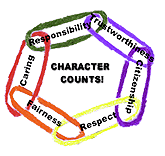TOP TEN LIST
What can be done to take character education from words to actionIn order to establish a character education initiative in schools and community, a number of essential elements are needed. An effective character education requires these ten factors to be in place. Individually, each is good--collectively, they form a powerful bond that can transform a school, district and community.
1. COLLABORATION: Educators, parents, students, and members of the community invest themselves in a consensus-building process to discover common ground that is essential for long-term success.
2. COMMITMENT: Character education is a part of the school district's philosophy, goal, or mission statement. Key administrators must be cognizant of the framework of character education and the strategies that can be used to create a process that moves from words to action.
3. SHARED BELIEFS AND CONSENSUS VALUES: Parents, teachers, and community representatives must agree on which character traits to emphasize and what definitions to use. Once the traits are defined, they should be highly visible throughout the school and community.
4. INTEGRATED CURRICULUM: Character education is an integral part of the curriculum at all grade levels. Character traits are connected to classroom lessons so students see how a trait might figure into a story, be part of a science experiment, or how it might affect them. Character education is not one more thing to add to a full plate - character education is the plate.
5. EXPERIENTIAL LEARNING: Students are given many opportunities to experience character traits, see them in action, and feel them rather than just talk about them. Community based projects or service learning experiences are encouraged by the school and community organizations.
6. EVALUATION: The character education initiative - including the implementation process, program activities, and impact on students - is evaluated on a regular basis. Evaluation data are used to improve the program.
7. MODELING: Children may not always listen to what we say, but they do believe what we do. Children "learn what they live" so it is important that all adults who interact with children demonstrate positive character traits at home, school and in the community.
8. TRAINING: Time and resources must be allocated for training educators and community leaders so the character education initiative expands throughout the curriculum and community life.
9. STUDENT INVOLVEMENT: Students are involved in age- appropriate activities and allowed to connect character education to their learning, decision making, and personal goals as the process is integrated across the curriculum.
10. SUSTAINING WHAT HAS BEEN STARTED: The character education program is sustained and renewed through implementation of the first nine essential elements. Establishing a community-based character coalition will be necessary to ensure the core ethical values are respected and recognized.



